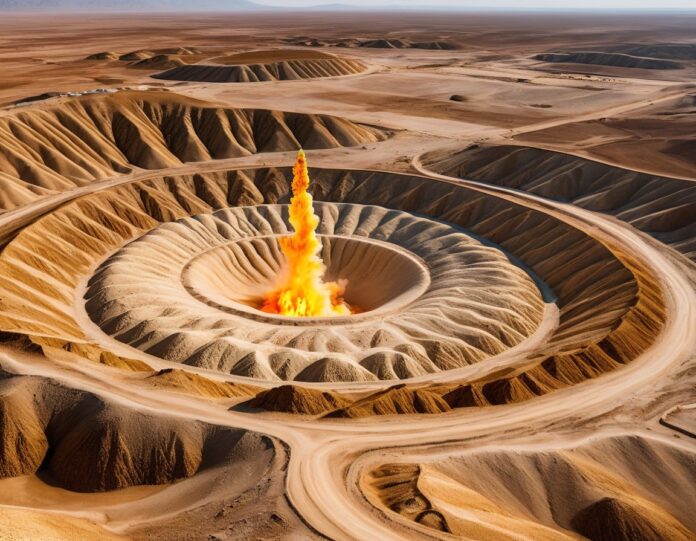Turkmenistan, often dubbed the “North Korea of Central Asia,” is a country that captivates with its unique blend of eccentricity and mystery. From monumental architecture made of gleaming white marble to surreal natural phenomena, it is one of the world’s most peculiar and secretive nations. Often considered the world’s strangest and most bizarre country Turkmenistan stands out through its strict authoritarian rule, bizarre laws, and strange customs, leaving many to wonder how such a country exists in the modern world.
A Nation Built on Peculiar Dictates
Turkmenistan’s peculiar nature is deeply rooted in the leadership of its former dictator, Saparmurat Niyazov, also known as “Turkmenbashi,” or “Father of all Turkmen.” Niyazov’s iron grip on the nation gave rise to an odd array of regulations. For instance, dogs were banned from the capital Ashgabat due to their “unpleasant odor,” and the country outlawed beards, long hair, and even lip-syncing at concerts.
One of his most famous legacies is the golden rotating statue of himself, standing 12 meters tall in Ashgabat. The statue was designed to always face the sun, symbolizing his desire for eternal reverence. But this was just one of his numerous ego-driven projects, which included renaming the months of the year after his family members and banning the use of satellite dishes to control what his citizens could watch.
Ashgabat: The City of White Marble
The capital, Ashgabat, holds the Guinness World Record for being the city with the most white marble-clad buildings in the world. This surreal metropolis is also home to the world’s largest indoor Ferris wheel, standing at 156 feet tall, another testament to Niyazov’s obsession with grandeur. Strolling through the city feels more like walking through an open-air museum of Niyazov’s extravagant visions than a capital of a modern state, showcasing why Turkmenistan is considered the world’s strangest and most bizarre country
The Door to Hell: A Perpetual Flame in the Desert
One of the most fascinating landmarks in Turkmenistan is the Darvaza Gas Crater, also known as the “Door to Hell.” Located in the middle of the vast Karakum Desert, this burning crater has been ablaze for over 50 years. In 1971, Soviet engineers accidentally ignited it while trying to burn off excess natural gas, expecting it to burn out in weeks. However, it continues to burn to this day, emitting flames and creating a hellish scene that attracts adventurous tourists, showcasing why Turkmenistan is the world’s strangest and most bizarre country.
Cultural Quirks and Traditions
In addition to its strange architecture and natural phenomena, Turkmenistan boasts quirky traditions. Turkmen weddings, for instance, are elaborate ceremonies steeped in ancient customs. Rituals include the symbolic exchange of gifts and the slaughter of a sheep for good fortune. Meanwhile, the Akhal-Teke horse, a shimmering golden breed, is revered as a national treasure, embodying the pride and strength of the Turkmen people.
A Closed-Off Nation
Dubbed one of the most isolated countries in the world, Turkmenistan is notoriously difficult to enter. Visas are hard to obtain, and travelers are required to be accompanied by a government-approved guide at all times. This makes it one of the least visited countries on Earth, adding to its enigmatic status. The country ranks near the bottom of the World Press Freedom Index, with only North Korea and Eritrea ranking lower.
Conclusion
Turkmenistan’s strange blend of bizarre laws, monumental architecture, and isolation make it one of the most fascinating countries on the planet. Its oddities, from the burning Door to Hell to its dictatorship-driven reforms, offer a glimpse into a world frozen in time, where the leader’s cult of personality shaped an entire nation’s identity.
Whether you’re captivated by its grandiose marble city, curious about its odd customs, or simply drawn by the mystery surrounding it, Turkmenistan is a country that continues to intrigue and bewilder.
FAQs
1. Why is Turkmenistan often referred to as the ‘North Korea of Central Asia’?
Turkmenistan is compared to North Korea due to its highly authoritarian government, extreme media censorship, and isolation from the global community. Under both Saparmurat Niyazov and his successor, Gurbanguly Berdimuhamedow, the government has maintained strict control over the population and heavily regulates outside information. Foreign visitors face difficulty entering the country, and all tourists must be accompanied by a government guide at all times. This combination of isolation and strict political rule gives Turkmenistan its reputation as the world’s strangest and most bizarre country.
2. What is the Darvaza Gas Crater, and why is it called the ‘Door to Hell’?
The Darvaza Gas Crater, also known as the “Door to Hell,” is a natural gas field in the Karakum Desert that collapsed into an underground cavern. Soviet engineers ignited the gas in 1971 to prevent it from spreading, believing it would burn out in a few weeks. However, the crater has continued to burn for over five decades, creating a spectacular—and eerie—sight. It is 60 meters wide and 30 meters deep, with flames continuously shooting from its depths, giving it the nickname “Door to Hell.”
3. What are some of the bizarre laws implemented in Turkmenistan?
Turkmenistan is known for several strange laws, many of which were introduced by former President Saparmurat Niyazov. Some of these include the banning of beards and long hair for men, outlawing lip-syncing at public concerts, and forbidding dogs in Ashgabat due to their supposed unpleasant smell. Niyazov also renamed months of the year after himself and his family members, and even banned smoking in all public places as well as for government employees. His successor has upheld some of these eccentric regulations while introducing others, like banning black cars in the capital.
4. Why does Ashgabat have so many white marble buildings?
Ashgabat, the capital of Turkmenistan, holds the Guinness World Record for the highest number of stunning white marble buildings globally. The city’s distinctive aesthetic is largely the result of former President Niyazov’s vision of grandeur. His aim was to create a capital that would symbolize Turkmenistan’s wealth and prestige. As a result, the government invested heavily in constructing monumental buildings clad in white marble, giving the city its unique, gleaming appearance. Today, Ashgabat’s architectural extravagance is one of its most striking features.
5. Why is Turkmenistan considered one of the least visited countries in the world?
Turkmenistan is one of the world’s least visited countries due to its restrictive visa policies and government control over tourism. Tourists must obtain special visas and can only explore the country with a government-approved guide. This discourages many travelers who seek independent travel experiences. Additionally, the nation’s strict control of information, lack of online presence, and isolationist policies make it difficult for potential visitors to access reliable information or plan a visit. These factors contribute to its reputation as a closed-off and mysterious country


